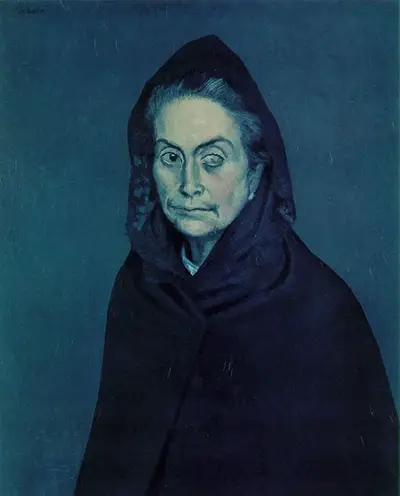Similar to other blue period portraits of late 1903 and early 1904, Celestina appears in isolation and is centrally placed in the canvas.
However, this portrait stands out from most of the paintings Picasso did during the blue period. The blue period is a reflection of the sadness and despair that Picasso was experiencing in his life.
It is inspired by his financial burdens and depression due to the fact that he lost his close friend and confidant Carlos Casagemas, who took his own life, after falling into hopeless infatuation with a girl whom he attempted to kill as well. Similarly, at the time, Picasso struggled as an unrecognized and unappreciated artist who lived in absolute poverty in Barcelona.
During this period, Picasso mainly used blue palettes to convey feelings of misery and misfortune. This monochromatic use of palettes was commonly used in many paintings in Spain and France, whereby it was often associated with the emotions of sorrow and hopelessness. Since he was living in Barcelona, Spain, he could not help but get influenced by the Spaniards and their way of life.
The blue period paintings of Picasso portray destitute beings. The blue palettes are used to intensify the hopelessness of the subjects depicted, such as beggars, prostitutes, blind, out of work actors, and circus folks, as well as Picasso himself and his penniless friends. However, rather than show their specific circumstance of misfortune, Picasso elongated his subject’s form endowing them with a unique sense of beauty and hope.
La Celestina is a painting of an old one- eyed woman who is dressed in somber color. She is partially blind and does not appear emaciated, contrary to other blue period paintings. She has rounded cheeks and a forceful and assertive presence. The painting is said to be inspired by Spanish literature as it is a reproduction of a character, also named Celestina, in a 15th century Spanish play, Aurora Roja. In the play, Celestina is a sorceress and procuress who casts magical spells and mixes portions. It is reported that Picasso was always fascinated by Spanish literature, ever since his adolescent years. While in Spain, he read various editions of the Spanish play.
Similarly, many of Picasso’s blue period paintings are said to resemble a lot of the works of El Greco, a Spanish painter. However, the feeling in Picasso’s work still remain authentically his own. He is said to have made use of El Greco’s elongate forms and hallucinatory space.
The painting was done in oil paint. Celestina’s face is painted in light colors, such as white, pinks and grays. The background of the portrait is done in dark blues hence providing a contrast which provides a sensation of a person suddenly appearing from an indistinguishable background.
Picasso made three sketches before finally drawing this portrait, each sketch different from the other. This revealed immense visual information as it shows his creative train of thought as he built up to the portrait of La Celestina.
La Celestina is based on a model that Picasso identifies, by means of inscription, at the back of his portrait as Carlota Valdivia. Carlota worked at a night spot where Picasso often visited as it was very near his studio in Barcelona. It is reported that the one- eyed Carlota inspired the pictorial imagination of Picasso and he transformed her to La Celestina.
The theme of blindness had a personal meaning for Picasso, who so predominantly lived by his eyes. In the late blue period, from 1903 and continuing into 1904, blindness received intense consideration in his work. He equated this infliction with a sharpening of the senses. Blindness for him signifies a deeper vision; a true glimpse of reality. Blindness for him, because of the lack of visual experience of the world, suggests the development of a more profound grasp of the true nature of things, without the restriction of physical sight.
La Celestina remains as perfect transformation of Aurora Roja’s text. The portrait conveys the same presence and psychological character of Celestina as in the play; a woman of tremendous force and who is in possession of extraordinary skills. The proverb ‘A picture is worth a thousand words’ applies to Picasso’s portrait. His painted version of Celestina, with her one good eye open to the carnal pleasures of men and women, re-affirms the creation of Aurora Roja’s play.

